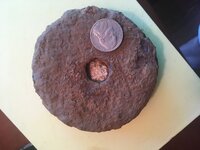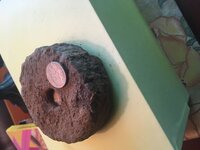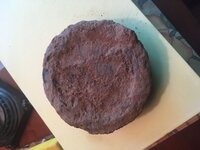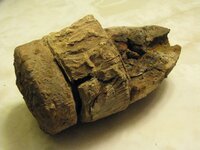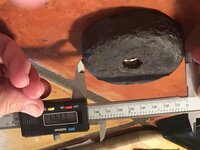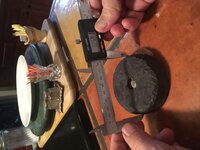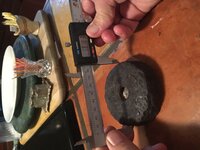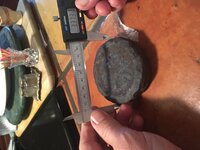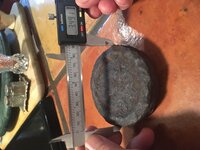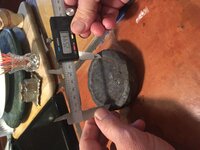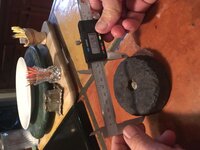Navigation
Install the app
How to install the app on iOS
Follow along with the video below to see how to install our site as a web app on your home screen.
Note: This feature may not be available in some browsers.
More options
You are using an out of date browser. It may not display this or other websites correctly.
You should upgrade or use an alternative browser.
You should upgrade or use an alternative browser.
Base of artillery shell or farm junk
- Thread starter Tigerdude
- Start date
TheCannonballGuy
Gold Member
- Feb 24, 2006
- 6,596
- 13,390
- Detector(s) used
- White's 6000, Nautilus DMC-1, Minelab
- Primary Interest:
- Relic Hunting
Sorry to have to tell you, it definitely is not the base of an exploded civil war era artillery shell. None of those have your object's OFF-CENTER flat-bottomed hole on a flat bottom.
Upvote
0
TheCannonballGuy
Gold Member
- Feb 24, 2006
- 6,596
- 13,390
- Detector(s) used
- White's 6000, Nautilus DMC-1, Minelab
- Primary Interest:
- Relic Hunting
I just now thought of a civil war artillery projectile possibility... the base of a "Flat-Base Hotchkiss," which was an early-war artillery shell used by the yankees, found only at battles along the lower Mississippi River, in that state and Louisiana. That "Flat-base" version of Hotchkiss shell is so extraordinarily rare (fewer than ten have ever been excavated) that I didn't immediately think of it as a possibility. Can you do Electrolysis on it, to remove the rust-encrustation, and give me a super-accurate measurement of its diameter, in hundredths-of-an-inch? You'll need a Digital Caliper for that kind of measuring. (Please measure the diameter in several directions across the flat bottom of the object.)
What put me onto the possibility was (1) your Southern Louisiana location, (2) the presence of a yankee Parrott shell's fuze nearby, and (3) the hole in the flat base appears to be filled with lead. Sometimes when a civil war (or earlier) artillery projectile came out of the ironcasting mold with a casting-flaw hole on its surface, the hole would be patched with lead.
If it is the "base-cup" part of a Flat-Base Hotchkiss, the sidewalls of the cup have been blown/broken off... which is another reason I didn't immediately think of it as an artillery shell's base. There seems to be a broken-off circular rim on the opposite side from where the hole is.
I must add, the possibility that it is the base of an extraordinarily rare Flat-Base Hotchkiss shell is kind of a stretch... but it's worth investigating. Precise measurement of the object's diameter will tell us whether it matches up with the diameter of a Flat-Base Hotchkiss shell, or not.
What put me onto the possibility was (1) your Southern Louisiana location, (2) the presence of a yankee Parrott shell's fuze nearby, and (3) the hole in the flat base appears to be filled with lead. Sometimes when a civil war (or earlier) artillery projectile came out of the ironcasting mold with a casting-flaw hole on its surface, the hole would be patched with lead.
If it is the "base-cup" part of a Flat-Base Hotchkiss, the sidewalls of the cup have been blown/broken off... which is another reason I didn't immediately think of it as an artillery shell's base. There seems to be a broken-off circular rim on the opposite side from where the hole is.
I must add, the possibility that it is the base of an extraordinarily rare Flat-Base Hotchkiss shell is kind of a stretch... but it's worth investigating. Precise measurement of the object's diameter will tell us whether it matches up with the diameter of a Flat-Base Hotchkiss shell, or not.
Attachments
Upvote
0
TheCannonballGuy
Gold Member
- Feb 24, 2006
- 6,596
- 13,390
- Detector(s) used
- White's 6000, Nautilus DMC-1, Minelab
- Primary Interest:
- Relic Hunting
I'm genuinely sorry to have to say, based on its very-precise measurement, your iron fragment is apparently not from a Hotchkiss Flat-Base projectile. Your measurements show its diameter ranges from 3.318 to 3.491-inches. That is too large to be from a 3.4-inch caliber Hotchkiss (actual diameter 3.31-inches), and too small to be from a 3.67-inch caliber Hotchkiss (actual diameter 3.58-inches). I was sincerely hoping for you that your find was part of a civil war artillery projectile. But the very precise caliper-made measurements eliminate that identification. Oh well... keep on detecting. The civil war Parrott shell's zinc fuzeplug is a definite sign that you're in the right area for more Artillery finds.
Upvote
0
Top Member Reactions
-
 3331
3331 -
 1921
1921 -
 1904
1904 -
 1189
1189 -
 1096
1096 -
 860
860 -
 807
807 -
 806
806 -
 796
796 -
 789
789 -
 768
768 -
 532
532 -
 492
492 -
 461
461 -
 429
429 -
 425
425 -
 423
423 -
E
409
-
 396
396 -
 396
396
Users who are viewing this thread
Total: 2 (members: 0, guests: 2)
